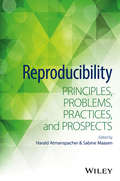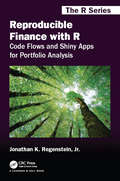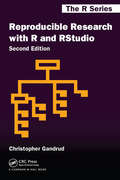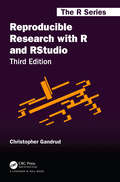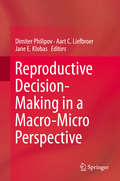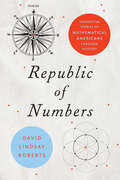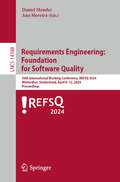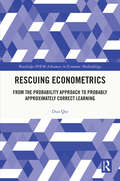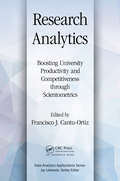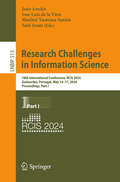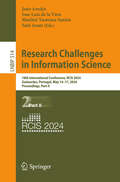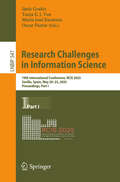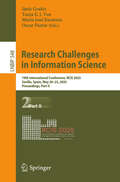- Table View
- List View
Representations of the Infinite Symmetric Group
by Alexei Borodin Grigori OlshanskiRepresentation theory of big groups is an important and quickly developing part of modern mathematics, giving rise to a variety of important applications in probability and mathematical physics. This book provides the first concise and self-contained introduction to the theory on the simplest yet very nontrivial example of the infinite symmetric group, focusing on its deep connections to probability, mathematical physics, and algebraic combinatorics. Following a discussion of the classical Thoma's theorem which describes the characters of the infinite symmetric group, the authors describe explicit constructions of an important class of representations, including both the irreducible and generalized ones. Complete with detailed proofs, as well as numerous examples and exercises which help to summarize recent developments in the field, this book will enable graduates to enhance their understanding of the topic, while also aiding lecturers and researchers in related areas.
Representative Points of Statistical Distributions: Applications in Statistical Inference
by Kai-Tai Fang Huajun Ye Yongdao ZhouStatistical simulation has become a cornerstone in statistical research and applications. The aim of Representative Points of Statistical Distributions: Applications in Statistical Inference is to present a comprehensive exploration of various methods for statistical simulation and resampling, focusing on consistency and efficiency. It covers a range of representative points (RPs) – Monte Carlo (MC) RPs, quasi-Monte Carlo (QMC) RPs, and mean square error (MSE) RPs – and their applications, and includes a collection of recent developments in the field. It also explores other types of representative points and the corresponding approximate distributions, and delves into the realm of statistical simulation by exploring the limitations of traditional MC methods and the innovations brought about by the bootstrap method. In addition, the text introduces other kinds of representative points and the corresponding approximate distributions such as QMC and MSE methods.Features Comprehensive exploration of statistical simulation methods: provides a deep dive into MC methods and bootstrap methods, and introduces other kinds of RPs and the corresponding approximate distributions, such as QMC and MSE methods. Emphasis on consistency and efficiency: highlights the advantages of these methods in terms of consistency and efficiency, addressing the slow convergence rate of classical statistical simulation. Collection of recent developments: brings together the latest advancements in the field of statistical simulation, keeping readers up to date with the most current research. Practical applications: includes numerous practical applications of various types of RPs (MC-RPs, QMC-RPs, and MSE-RPs) in statistical inference and simulation. Educational resource: can serve as a textbook for postgraduate students, a reference book for undergraduate students, and a valuable resource for professionals in various fields. The book serves as a valuable resource for postgraduate students, researchers, and practitioners in statistics, mathematics, and other quantitative fields.
Representing Finite Groups
by Ambar N. SenguptaThis graduate textbook presents the basics of representation theory for finite groups from the point of view of semisimple algebras and modules over them. The presentation interweaves insights from specific examples with development of general and powerful tools based on the notion of semisimplicity. The elegant ideas of commutant duality are introduced, along with an introduction to representations of unitary groups. The text progresses systematically and the presentation is friendly and inviting. Central concepts are revisited and explored from multiple viewpoints. Exercises at the end of the chapter help reinforce the material. Representing Finite Groups: A Semisimple Introduction would serve as a textbook for graduate and some advanced undergraduate courses in mathematics. Prerequisites include acquaintance with elementary group theory and some familiarity with rings and modules. A final chapter presents a self-contained account of notions and results in algebra that are used. Researchers in mathematics and mathematical physics will also find this book useful. A separate solutions manual is available for instructors.
Reproducibility: Principles, Problems, Practices, and Prospects
by Sabine Maasen Harald Atmanspacher"A comprehensive, insightful treatment of the reproducibility challenges facing science today and of ways in which the scientific community can address them." - Kathleen Hall Jamieson, Elizabeth Ware Packard Professor of Communication, University of Pennsylvania "How can we make sure that reproducible research remains a key imperative of scientific communication under increasing commercialization, media attention, and publication pressure? This handbook offers the first interdisciplinary and fundamental treatment of this important question." - Torsten Hothorn, Professor of Biostatistics, University of Zurich Featuring peer-reviewed contributions from noted experts in their fields of research, Reproducibility: Principles, Problems, Practices, and Prospects presents state-of-the-art approaches to reproducibility, the gold standard of sound science, from multi- and interdisciplinary perspectives. Including comprehensive coverage for implementing and reflecting the norm of reproducibility in various pertinent fields of research, the book focuses on how the reproducibility of results is applied, how it may be limited, and how such limitations can be understood or even controlled in the natural sciences, computational sciences, life sciences, social sciences, and studies of science and technology. The book presents many chapters devoted to a variety of methods and techniques, as well as their epistemic and ontological underpinnings, which have been developed to safeguard reproducible research and curtail deficits and failures. The book also investigates the political, historical, and social practices that underlie reproducible research in contemporary science studies, including the difficulties of good scientific practice and the ethos of reproducibility in modern innovation societies. Reproducibility: Principles, Problems, Practices, and Prospects is a guide for researchers who are interested in the general and overarching questions behind the concept of reproducibility; for active scientists who are confronted with practical reproducibility problems in their everyday work; and for economic stakeholders and political decision makers who need to better understand the challenges of reproducibility. In addition, the book is a useful in-depth primer for undergraduate and graduate-level courses in scientific methodology and basic issues in the philosophy and sociology of science from a modern perspective.
Reproducible Finance with R: Code Flows and Shiny Apps for Portfolio Analysis (Chapman & Hall/CRC The R Series)
by Jonathan K. Regenstein Jr.<p>Reproducible Finance with R: Code Flows and Shiny Apps for Portfolio Analysis is a unique introduction to data science for investment management that explores the three major R/finance coding paradigms, emphasizes data visualization, and explains how to build a cohesive suite of functioning Shiny applications. The full source code, asset price data and live Shiny applications are available at reproduciblefinance.com. <p>The ideal reader works in finance or wants to work in finance and has a desire to learn R code and Shiny through simple, yet practical real-world examples. <p>The book begins with the first step in data science: importing and wrangling data, which in the investment context means importing asset prices, converting to returns, and constructing a portfolio. The next section covers risk and tackles descriptive statistics such as standard deviation, skewness, kurtosis, and their rolling histories. The third section focuses on portfolio theory, analyzing the Sharpe Ratio, CAPM, and Fama French models. The book concludes with applications for finding individual asset contribution to risk and for running Monte Carlo simulations. For each of these tasks, the three major coding paradigms are explored and the work is wrapped into interactive Shiny dashboards.</p>
Reproducible Research with R and R Studio (Chapman & Hall/CRC The R Series #13)
by Christopher GandrudAll the Tools for Gathering and Analyzing Data and Presenting Results Reproducible Research with R and RStudio, Second Edition brings together the skills and tools needed for doing and presenting computational research. Using straightforward examples, the book takes you through an entire reproducible research workflow. This practical workflow enables you to gather and analyze data as well as dynamically present results in print and on the web. New to the Second Edition The rmarkdown package that allows you to create reproducible research documents in PDF, HTML, and Microsoft Word formats using the simple and intuitive Markdown syntax Improvements to RStudio’s interface and capabilities, such as its new tools for handling R Markdown documents Expanded knitr R code chunk capabilities The kable function in the knitr package and the texreg package for dynamically creating tables to present your data and statistical results An improved discussion of file organization, enabling you to take full advantage of relative file paths so that your documents are more easily reproducible across computers and systems The dplyr, magrittr, and tidyr packages for fast data manipulation Numerous modifications to R syntax in user-created packages Changes to GitHub’s and Dropbox’s interfaces Create Dynamic and Highly Reproducible Research This updated book provides all the tools to combine your research with the presentation of your findings. It saves you time searching for information so that you can spend more time actually addressing your research questions. Supplementary files used for the examples and a reproducible research project are available on the author’s website.
Reproducible Research with R and RStudio (Chapman & Hall/CRC The R Series)
by Christopher GandrudPraise for previous editions:"Gandrud has written a great outline of how a fully reproducible research project should look from start to finish, with brief explanations of each tool that he uses along the way… Advanced undergraduate students in mathematics, statistics, and similar fields as well as students just beginning their graduate studies would benefit the most from reading this book. Many more experienced R users or second-year graduate students might find themselves thinking, ‘I wish I’d read this book at the start of my studies, when I was first learning R!’…This book could be used as the main text for a class on reproducible research …" (The American Statistician) Reproducible Research with R and R Studio, Third Edition brings together the skills and tools needed for doing and presenting computational research. Using straightforward examples, the book takes you through an entire reproducible research workflow. This practical workflow enables you to gather and analyze data as well as dynamically present results in print and on the web. Supplementary materials and example are available on the author’s website. New to the Third Edition Updated package recommendations, examples, URLs, and removed technologies no longer in regular use. More advanced R Markdown (and less LaTeX) in discussions of markup languages and examples. Stronger focus on reproducible working directory tools. Updated discussion of cloud storage services and persistent reproducible material citation. Added discussion of Jupyter notebooks and reproducible practices in industry. Examples of data manipulation with Tidyverse tibbles (in addition to standard data frames) and pivot_longer() and pivot_wider() functions for pivoting data. Features Incorporates the most important advances that have been developed since the editions were published Describes a complete reproducible research workflow, from data gathering to the presentation of results Shows how to automatically generate tables and figures using R Includes instructions on formatting a presentation document via markup languages Discusses cloud storage and versioning services, particularly Github Explains how to use Unix-like shell programs for working with large research projects
Reproduction and Social Organization in Sub-Saharan Africa (Studies in Demography #4)
by Ron J. LesthaegheUnlike most Asian and Latin American countries, sub-Saharan Africa has seen both an increase in population growth rates and a weakening of traditional patterns of child-spacing since the 1960s. It is tempting to conclude that sub-Saharan countries have simply not reached adequate levels of income, education, and urbanization for a fertility decline to occur. This book argues, however, that such a socioeconomic threshold hypothesis will not provide an adequate basis for comparison. These authors take the view that any reproductive regime is also anchored to a broader pattern of social organization, including the prevailing modes of production, rules of exchange, patterns of religious systems, kinship structure, division of labor, and gender roles. They link the characteristic features of the African reproductive regime with regard to nuptiality, polygyny, breastfeeding, postpartum abstinence, sterility, and child-fostering to other specifically African characteristics of social organization and culture. Substantial attention is paid to the heterogeneity that prevails among sub-Saharan societies and considerable use is made, therefore, of interethnic comparisons. As a result the book goes considerably beyond mere demographic description and builds bridges between demography and anthropology or sociology. This title is part of UC Press's Voices Revived program, which commemorates University of California Press’s mission to seek out and cultivate the brightest minds and give them voice, reach, and impact. Drawing on a backlist dating to 1893, Voices Revived makes high-quality, peer-reviewed scholarship accessible once again using print-on-demand technology. This title was originally published in 1989.
Reproductive Decision-Making in a Macro-Micro Perspective
by Dimiter Philipov Aart C. Liefbroer Jane E. KlobasThis book provides new insights into the significant gap that currently exists between desired and actual fertility in Europe. It examines how people make decisions about having children and demonstrates how the macro-level environment affects micro-level decision-making. Written by an international team of leading demographers and psychologists, the book presents the theoretical and methodological developments of a three-year, European Commission-funded project named REPRO (Reproductive Decision-Making in a Macro-Micro Perspective). It also provides an overview of the research conducted by REPRO researchers both during and after the project. The book examines fertility intentions from quantitative and qualitative perspectives, demonstrates how the macro-level environment affects micro-level decision-making, and offers a multi-level analysis of fertility-related norms across Europe. Overall, this book offers insight into how people make decisions to have children, when they are most likely to act on their decisions, and how different social and policy settings affect their decisions and actions. It will appeal to researchers, graduate students, and policy advisors with an interest in fertility, demography, and life-course decision making.
Republic of Numbers: Unexpected Stories of Mathematical Americans through History
by David Lindsay RobertsThis fascinating narrative history of math in America introduces readers to the diverse and vibrant people behind pivotal moments in the nation's mathematical maturation.Once upon a time in America, few knew or cared about math. In Republic of Numbers, David Lindsay Roberts tells the story of how all that changed, as America transformed into a powerhouse of mathematical thinkers. Covering more than 200 years of American history, Roberts recounts the life stories of twenty-three Americans integral to the evolution of mathematics in this country. Beginning with self-taught Salem mathematician Nathaniel Bowditch's unexpected breakthroughs in ocean navigation and closing with the astounding work Nobel laureate John Nash did on game theory, this book is meant to be read cover to cover. Revealing the marvelous ways in which America became mathematically sophisticated, the book introduces readers to Kelly Miller, the first black man to attend Johns Hopkins, who brilliantly melded mathematics and civil rights activism; Izaak Wirszup, a Polish immigrant who survived the Holocaust and proceeded to change the face of American mathematical education; Grace Hopper, the "Machine Whisperer," who pioneered computer programming; and many other relatively unknown but vital figures. As he brings American history and culture to life, Roberts also explains key mathematical concepts, from the method of least squares, propositional logic, quaternions, and the mean-value theorem to differential equations, non-Euclidean geometry, group theory, statistical mechanics, and Fourier analysis. Republic of Numbers will appeal to anyone who is interested in learning how mathematics has intertwined with American history.
Requirements Engineering: 30th International Working Conference, REFSQ 2024, Winterthur, Switzerland, April 8–11, 2024, Proceedings (Lecture Notes in Computer Science #14588)
by Daniel Mendez Ana MoreiraThis book constitutes the refereed proceedings of the 30th International Working Conference on Requirements Engineering: Foundation for Software Quality, REFSQ 2024, held in Winterthur, Switzerland, during April 8–12, 2024.The 14 full papers and 8 short papers included in this book were carefully reviewed and selected from 59 submissions. They are organized in topical sections as follows: quality models for requirements engineering; quality requirements; explainability with and in requirements engineering; artificial intelligence for requirements engineering; natural language processing for requirements engineering; requirements engineering for artificial intelligence; crowd-based requirements engineering; and emerging topics and challenges in requirements engineering.
Requirements Engineering: 31st International Working Conference, REFSQ 2025, Barcelona, Spain, April 7–10, 2025, Proceedings (Lecture Notes in Computer Science #15588)
by Anne Hess Angelo SusiThis book constitutes the refereed proceedings of the 31st International Working Conference on Requirements Engineering: Foundation for Software Quality, REFSQ 2025, held in Barcelona, Spain, during April 7–10, 2025. The 21 full papers and 8 short papers included in this book were carefully reviewed and selected from 74 submissions. They were organized in topical sections as follows: Responsible RE; Crowd and Large-Scale RE; Requirements Modeling; Requirements Elicitation and Analysis; Participatory RE; RE for Safety-critical and Autonomous Systems; and Requirements Quality Assurance.
Rescuing Econometrics: From the Probability Approach to Probably Approximately Correct Learning (Routledge INEM Advances in Economic Methodology)
by Duo QinHaavelmo’s 1944 monograph, The Probability Approach in Econometrics, is widely acclaimed as the manifesto of econometrics. This book challenges Haavelmo’s probability approach, shows how its use is delivering defective and inefficient results, and argues for a paradigm shift in econometrics towards a full embrace of machine learning, with its attendant benefits. Machine learning has only come into existence over recent decades, whereas the universally accepted and current form of econometrics has developed over the past century. A comparison between the two is, however, striking. The practical achievements of machine learning significantly outshine those of econometrics, confirming the presence of widespread inefficiencies in current econometric research. The relative efficiency of machine learning is based on its theoretical foundation, and particularly on the notion of Probably Approximately Correct (PAC) learning. Careful examination reveals that PAC learning theory delivers the goals of applied economic modelling research far better than Haavelmo’s probability approach. Econometrics should therefore renounce its outdated foundation, and rebuild itself upon PAC learning theory so as to unleash its pent-up research potential. The book is catered for applied economists, econometricians, economists specialising in the history and methodology of economics, advanced students, philosophers of social sciences.
Research Analytics: Boosting University Productivity and Competitiveness through Scientometrics (Data Analytics Applications)
by Francisco J. Cantu-OrtizThe growth of machines and users of the Internet has led to the proliferation of all sorts of data concerning individuals, institutions, companies, governments, universities, and all kinds of known objects and events happening everywhere in daily life. Scientific knowledge is not an exception to the data boom. The phenomenon of data growth in science pushes forth as the number of scientific papers published doubles every 9–15 years, and the need for methods and tools to understand what is reported in scientific literature becomes evident. <P><P>As the number of academicians and innovators swells, so do the number of publications of all types, yielding outlets of documents and depots of authors and institutions that need to be found in Bibliometric databases. These databases are dug into and treated to hand over metrics of research performance by means of Scientometrics that analyze the toil of individuals, institutions, journals, countries, and even regions of the world. The objective of this book is to assist students, professors, university managers, government, industry, and stakeholders in general, understand which are the main Bibliometric databases, what are the key research indicators, and who are the main players in university rankings and the methodologies and approaches that they employ in producing ranking tables. <P><P>The book is divided into two sections. The first looks at Scientometric databases, including Scopus and Google Scholar as well as institutional repositories. The second section examines the application of Scientometrics to world-class universities and the role that Scientometrics can play in competition among them. It looks at university rankings and the methodologies used to create these rankings. Individual chapters examine specific rankings that include: <P><P> <P><P>QS World University <P><P>Scimago Institutions <P><P>Webometrics <P><P>U-Multirank <P><P>U.S. News & World Report <P><P>The book concludes with a discussion of university performance in the age of research analytics.
Research Challenges in Information Science: 18th International Conference, RCIS 2024, Guimarães, Portugal, May 14–17, 2024, Proceedings, Part I (Lecture Notes in Business Information Processing #513)
by Saïd Assar João Araújo Maribel Yasmina Santos Jose Luis de la VaraThis book constitutes the proceedings of the 18th International Conference on Research Challenges in Information Sciences, RCIS 2024, which took place in Guimarães, Portugal, during May 2024. The scope of RCIS is summarized by the thematic areas of information systems and their engineering; user-oriented approaches; data and information management; business process management; domain-specific information systems engineering; data science; information infrastructures, and reflective research and practice. The 25 full papers, 12 Forum and 5 Doctoral Consortium papers included in these proceedings were carefully reviewed and selected from 100 submissions. They were organized in topical sections as follows: Part I: Data and information management; conceptual modelling and ontologies; requirements and architecture; business process management; data and process science; security; sustainability; evaluation and experience studies Part II: Forum papers; doctoral consortium papers.
Research Challenges in Information Science: 18th International Conference, RCIS 2024, Guimarães, Portugal, May 14–17, 2024, Proceedings, Part II (Lecture Notes in Business Information Processing #514)
by Saïd Assar João Araújo Maribel Yasmina Santos Jose Luis de la VaraThis book constitutes the proceedings of the 18th International Conference on Research Challenges in Information Sciences, RCIS 2024, which took place in Guimarães, Portugal, during May 2024. The scope of RCIS is summarized by the thematic areas of information systems and their engineering; user-oriented approaches; data and information management; business process management; domain-specific information systems engineering; data science; information infrastructures, and reflective research and practice. The 25 full papers, 12 Forum and 5 Doctoral Consortium papers included in these proceedings were carefully reviewed and selected from 100 submissions. They were organized in topical sections as follows: Part I: Data and information management; conceptual modelling and ontologies; requirements and architecture; business process management; data and process science; security; sustainability; evaluation and experience studies Part II: Forum papers; doctoral consortium papers.
Research Challenges in Information Science: 19th International Conference, RCIS 2025, Seville, Spain, May 20–23, 2025, Proceedings, Part I (Lecture Notes in Business Information Processing #547)
by Tanja E. J. Vos Oscar Pastor Maria José Escalona Jānis GrabisThe two-volume set LNBIP 547 and LNBIP 548 constitutes the proceedings of the 19th International Conference on Research Challenges in Information Sciences, RCIS 2025, which took place in Seville, Spain, in May 2025. It focused on the special theme: Advancing Information Science and Information Systems Quality in the Era of Complexity. The scope of RCIS is summarized by the thematic areas of information systems and their engineering; user-oriented approaches; data and information management; business process management; domain-specific information systems engineering; data science; information infrastructures, and reflective research and practice. The 33 full papers and 13 short papers included in the proceedings were carefully reviewed and selected from 103 submissions. They were organized in topical sections as follows: Part I: Information systems quality; security, risk and strategy; conceptual modeling and ontologies; modeling methods and requiremments engineering; databases informaiton management; human factors in information systems; business process engineering and management; Part II: Machine-learning and generative AI applications; RCIS Forum; and RCIS Doctoral Consortium.
Research Challenges in Information Science: 19th International Conference, RCIS 2025, Seville, Spain, May 20–23, 2025, Proceedings, Part II (Lecture Notes in Business Information Processing #548)
by Tanja E. J. Vos Oscar Pastor Maria José Escalona Jānis GrabisThe two-volume set LNBIP 547 + LNBIP 548 constitutes the proceedings of the 19th International Conference on Research Challenges in Information Sciences, RCIS 2025, which took place in Seville, Spain, in May 2025. It focused on the special theme: Advancing Information Science and Information Systems Quality in the Era of Complexity. The scope of RCIS is summarized by the thematic areas of information systems and their engineering; user-oriented approaches; data and information management; business process management; domain-specific information systems engineering; data science; information infrastructures, and reflective research and practice. The 33 full papers and 13 short papers included in the proceedings were carefully reviewed and selected from 103 submissions. They were organized in topical sections as follows: Part I: Information systems quality; security, risk and strategy; conceptual modeling and ontologies; modeling methods and requiremments engineering; databases informaiton management; human factors in information systems; business process engineering and management; Part II: Machine-learning and generative AI applications; RCIS Forum; and RCIS Doctoral Consortium.
Research Connections: Career and Research Journeys from the SMP Community (Association for Women in Mathematics Series #36)
by Karen Lange Erin McNicholas Abra Brisbin Emilie PurvineWhat does math research really look like? Which subfield is right for me? Do people like me go to graduate school, and succeed? This book provides students a “sneak preview” of math research in a variety of subfields. Each chapter features the work of a different mathematician along with enough background material for an advanced undergraduate or early graduate student to understand the key ideas and get a sense for the styles of thinking involved in each subfield. Each chapter is prefaced by a short biography of the mathematician who wrote the chapter (all people connected to the Carleton College Summer Math Program for Women), providing advice and examples of paths from undergraduate education, through graduate school and beyond. This book provides a source of ideas and starting points for in-class projects, independent studies, and student talks as well as supplementary reading in courses. The profiles of early career mathematicians and statisticians at the beginning of each chapter are valuable as an advising resource for students considering graduate school, or to show students a diverse view of modern mathematicians in a “Math for Liberal Arts”-style course.
Research Design and Statistical Analysis
by Jerome L. Myers Arnold D. Well Caren M. Rotello Robert F. Lorch, Jr.This fully updated fourth edition of Research Design and Statistical Analysis provides comprehensive coverage of the design principles and statistical concepts necessary to make sense of real data. The guiding philosophy is to provide a strong conceptual foundation so that readers can generalize to new situations they encounter in their research, including new developments in data analysis.Key features include: Emphasis on basic concepts such as sampling distributions, design efficiency, and expected mean squares, relating the research designs and data analyses to the statistical models that underlie the analyses. Detailed instructions on performing analysis using both R and SPSS. Pedagogical exercises mapped to key topic areas to support students as they review their understanding and strive to reach their higher learning goals. Incorporating the analyses of both experimental and observational data, and with coverage that is broad and deep enough to serve a two-semester sequence, this textbook is suitable for researchers, graduate students and advanced undergraduates in psychology, education, and other behavioral, social, and health sciences.The book is supported by a robust set of digital resources, including data files and exercises from the book in an Excel format for easy import into R or SPSS; R scripts for running example analysis and generating figures; and a solutions manual.
Research Design and Statistical Analysis: Third Edition (Inquiry And Pedagogy Across Diverse Contexts Ser.)
by Jerome L. Myers Arnold D. Well Robert F. Lorch JrResearch Design and Statistical Analysis provides comprehensive coverage of the design principles and statistical concepts necessary to make sense of real data. The book’s goal is to provide a strong conceptual foundation to enable readers to generalize concepts to new research situations. Emphasis is placed on the underlying logic and assumptions of the analysis and what it tells the researcher, the limitations of the analysis, and the consequences of violating assumptions. Sampling, design efficiency, and statistical models are emphasized throughout. As per APA recommendations, emphasis is also placed on data exploration, effect size measures, confidence intervals, and using power analyses to determine sample size. "Real-world" data sets are used to illustrate data exploration, analysis, and interpretation. The book offers a rare blend of the underlying statistical assumptions, the consequences of their violations, and practical advice on dealing with them. Changes in the New Edition: Each section of the book concludes with a chapter that provides an integrated example of how to apply the concepts and procedures covered in the chapters of the section. In addition, the advantages and disadvantages of alternative designs are discussed. A new chapter (1) reviews the major steps in planning and executing a study, and the implications of those decisions for subsequent analyses and interpretations. A new chapter (13) compares experimental designs to reinforce the connection between design and analysis and to help readers achieve the most efficient research study. A new chapter (27) on common errors in data analysis and interpretation. Increased emphasis on power analyses to determine sample size using the G*Power 3 program. Many new data sets and problems. More examples of the use of SPSS (PASW) Version 17, although the analyses exemplified are readily carried out by any of the major statistical software packages. A companion website with the data used in the text and the exercises in SPSS and Excel formats; SPSS syntax files for performing analyses; extra material on logistic and multiple regression; technical notes that develop some of the formulas; and a solutions manual and the text figures and tables for instructors only. Part 1 reviews research planning, data exploration, and basic concepts in statistics including sampling, hypothesis testing, measures of effect size, estimators, and confidence intervals. Part 2 presents between-subject designs. The statistical models underlying the analysis of variance for these designs are emphasized, along with the role of expected mean squares in estimating effects of variables, the interpretation of nteractions, and procedures for testing contrasts and controlling error rates. Part 3 focuses on repeated-measures designs and considers the advantages and disadvantages of different mixed designs. Part 4 presents detailed coverage of correlation and bivariate and multiple regression with emphasis on interpretation and common errors, and discusses the usefulness and limitations of these procedures as tools for prediction and for developing theory. This is one of the few books with coverage sufficient for a 2-semester course sequence in experimental design and statistics as taught in psychology, education, and other behavioral, social, and health sciences. Incorporating the analyses of both experimental and observational data provides continuity of concepts and notation. Prerequisites include courses on basic research methods and statistics. The book is also an excellent resource for practicing researchers.
Research Design: Qualitative, Quantitative, And Mixed Methods Approaches (Fourth Edition)
by John W. CreswellThe eagerly anticipated Fourth Edition of the title that pioneered the comparison of qualitative, quantitative, and mixed methods research design is here! For all three approaches, Creswell includes a preliminary consideration of philosophical assumptions, a review of the literature, an assessment of the use of theory in research approaches, and reflections about the importance of writing and ethics in scholarly inquiry. He also presents the key elements of the research process, giving specific attention to each approach. The Fourth Edition includes extensively revised mixed methods coverage, increased coverage of ethical issues in research, and an expanded emphasis on worldview perspectives.
Research Design: Qualitative, Quantitative, and Mixed Methods Approaches
by John W. CreswellThe Bestselling Text is Completely Updated and Better than Ever Praise for the Third Edition I have used the older edition with great success. The new one is even better. -Kathleen Duncan, "University of La Verne" The Third Edition of the bestselling text Research Design by John W. Creswell enables readers to compare three approaches to research-qualitative, quantitative, and mixed methods-in a single research methods text. The book presents these three approaches side by side within the context of the process of research from the beginning steps of philosophical assumptions to the writing and presenting of research. Written in a user-friendly manner, Creswells text does not rely on technical jargon. He cuts to the core of what a reader needs to know to read and design research in part by showcasing ideas in a scaffold approach so that the reader understands ideas from the simple to the complex. Key updates to the Third Edition Presents the preliminary steps of using philosophical assumptions in the beginning of the book Provides an expanded discussion on ethical issues Emphasizes new Web-based technologies for literature searches Offers updated information about mixed methods research procedures Contains a glossary of terms Highlights research tips throughout the chapters incorporating the author s experiences over the last 35 years.
Research Design: Qualitative, Quantitative, and Mixed Methods Approaches (Fourth Edition)
by John W. CreswellThe eagerly anticipated Fourth Edition of the title that pioneered the comparison of qualitative, quantitative, and mixed methods research design is here! For all three approaches, Creswell includes a preliminary consideration of philosophical assumptions, a review of the literature, an assessment of the use of theory in research approaches, and refl ections about the importance of writing and ethics in scholarly inquiry. He also presents the key elements of the research process, giving specifi c attention to each approach. The Fourth Edition includes extensively revised mixed methods coverage, increased coverage of ethical issues in research, and an expanded emphasis on worldview perspectives.
Research Directions in Number Theory: Women in Numbers IV (Association for Women in Mathematics Series #19)
by Jennifer S. Balakrishnan Amanda Folsom Matilde Lalín Michelle ManesThese proceedings collect several number theory articles, most of which were written in connection to the workshop WIN4: Women in Numbers, held in August 2017, at the Banff International Research Station (BIRS) in Banff, Alberta, Canada. It collects papers disseminating research outcomes from collaborations initiated during the workshop as well as other original research contributions involving participants of the WIN workshops. The workshop and this volume are part of the WIN network, aimed at highlighting the research of women and gender minorities in number theory as well as increasing their participation and boosting their potential collaborations in number theory and related fields.



